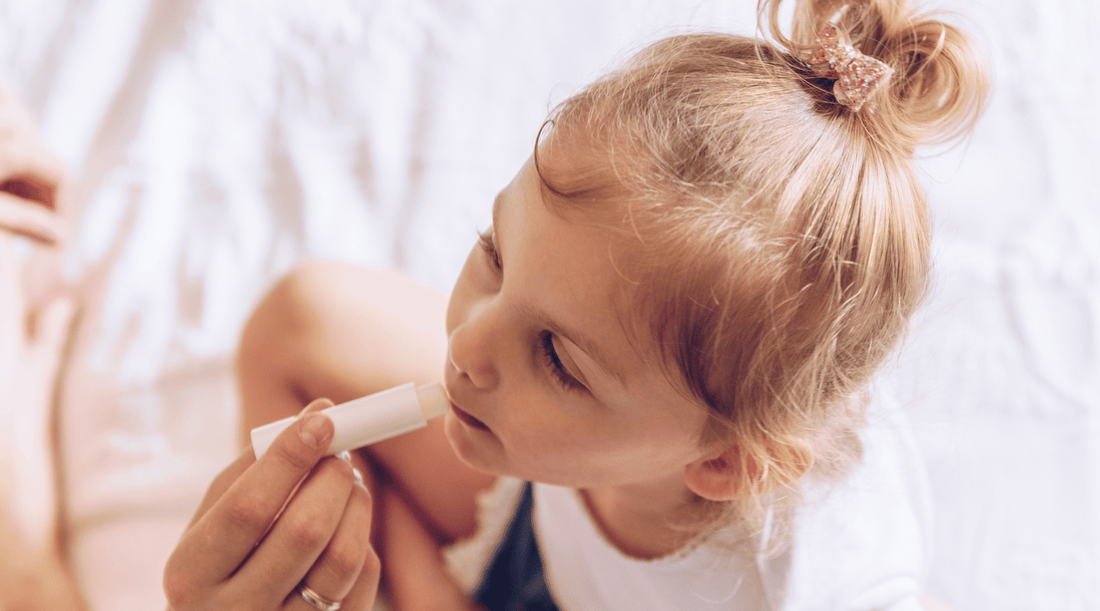Winter is here and so is the season of sniffles, coughs, and dry air. With illness running rife in schools and households, it’s no surprise that children’s skin is taking a hit. One of the most common (and uncomfortable) symptoms we’re seeing? Chapped, dry lips.
Between dehydration from being unwell, constant mouth-breathing due to congestion, and exposure to harsh winter air, kids are struggling to keep their lips soft and smooth. And while a swipe of lip balm might seem like a quick fix, not all balms are made for sensitive little lips.
The hidden problem with mainstream lip balms
While it’s tempting to grab a familiar lip balm off the shelf, many mainstream options (especially those targeted at children) do far more harm than good. Behind the glossy branding and “soothing” claims are formulas packed with ingredients that can irritate delicate skin, trigger allergies, or even make chapped lips worse over time.
Let’s take a well-known lip balm brand that’s been around for decades, one that many of us grew up with. I'm not here to name and shame, but I do think it’s important to shine a light on what’s actually going onto your child’s lips. Here’s the ingredient list:
Petrolatum, Paraffin, Mineral Oil, Octyldodecanol, Bis-Diglyceryl Polyacyladipate-2, Caprylic/Capric Triglyceride, Arachidyl Propionate, Phenyl Trimethicone, Beeswax, Copernicia Cerifera (Carnauba) Wax, Isopropyl Myristate, Flavor, Cetyl Alcohol, Lecithin (Soy), Benzyl Benzoate, Titanium Dioxide, Synthetic Wax, Triacetin, Saccharin, Yellow 5 Lake, Isopropyl Titanium Triisostearate, BHT, Blue 1 Lake.
While I wouldn't go near the bulk of these ingredients, the bits I've highlighted in yellow concern me most, and they should concern you too - here's why!
Petrolatum, paraffin, mineral oil
These are all made from petroleum (yes, the same stuff used in car fuel). While they might make lips feel better at first, they don’t actually help heal the skin and can trap bacteria underneath.
Octyldodecanol, isopropyl myristate
Hard-to-pronounce chemicals that can be rough on sensitive skin. They’re added to make the balm feel smooth, but they’ve been linked to irritation.
Flavour
Seems harmless, right? But “flavour” is a catch-all term that can include all sorts of hidden chemicals. If your child’s lips sting after applying lip balm, this could be why.
Lecithin (soy)
Often made from genetically modified soy and can be a trigger for kids with allergies or sensitivities.
Benzyl benzoate
This one’s used to keep products stable, but it’s also known to cause skin reactions - especially on delicate, cracked lips.
BHT
A synthetic preservative that’s under scrutiny for potential hormone-disrupting effects. Not something we want in kids’ daily skincare.
Saccharin
An artificial sweetener that can make lip balm taste nice but it also encourages lip licking, which just makes chapped lips worse.
Yellow 5 lake, Blue 1 lake
Artificial colours added purely for looks. They don’t do anything helpful and can cause reactions in some kids.
These ingredients may be legally approved for use, but they’re not what we’d call child-safe or skin kind. The cumulative effect of daily exposure, especially on vulnerable lips, is a risk not worth taking.
What makes our Kids Lip Balm different?
At Skin Botanist, we believe skincare should be safe, gentle, and effective. That’s why our Kids Lip Balm is made with nourishing, all-natural ingredients like beeswax, shea butter, and coconut oil - no synthetic additives, no irritants, and absolutely no sting.
One happy customer recently bought a balm for each of her 3 grandsons and shared:
“The boys love them and are using them already. They are happy because they don't sting!”
That’s the kind of feedback we love to hear. When kids are reaching for their balm on their own, you know it’s a winner.
Tips for preventing chapped lips in kids
- Keep them hydrated – Illness and cold weather can dry them out fast.
- Discourage lip licking – It only makes things worse.
- Use a humidifier – Especially if the heater’s running at night.
- Apply a natural lip balm regularly – Look for gentle, child-friendly formulas, likes ours!
This winter, support your child’s comfort with skincare that’s made with care. Don’t be fooled by clever marketing or decades-old brand loyalty. At the end of the day, their top priority isn’t your child’s skin - it’s their bottom line.

